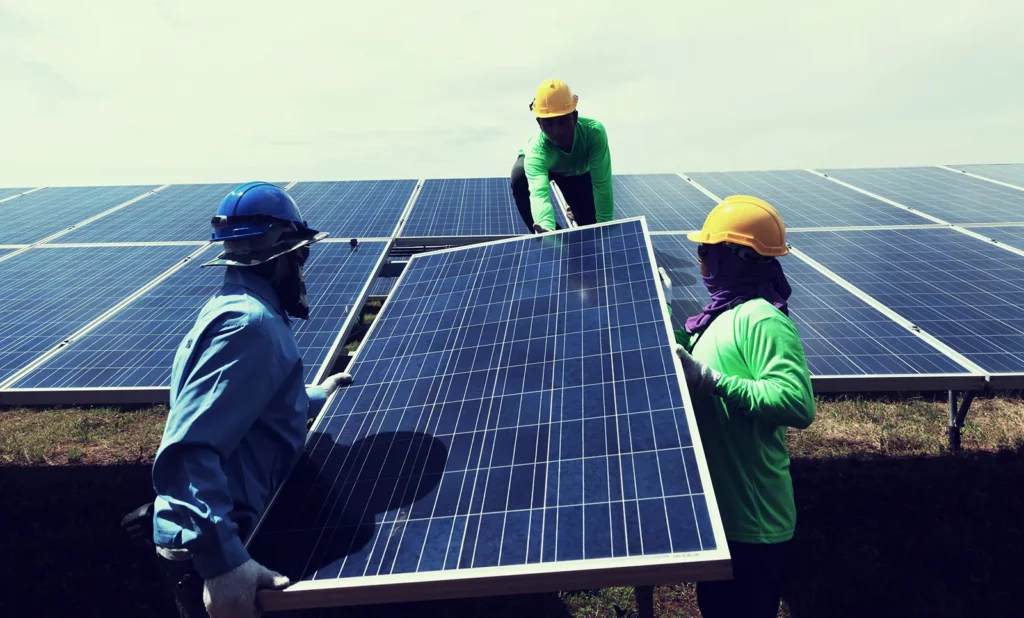The solar panel (solar cell) was discovered by the French physicist Alexander Edmond Becquerel in 1839, to detect the first photovoltaic effect in the world. He discovered this effect while testing his work on Becquerel platinum sheets.
Introduction of solar panel:
1873 A scientist named Willoughby Smith discovered photoconductivity in selenium. And as the first photovoltaic assembly, it made history in the field of solar panel systems. 1877 Scientists named WGAdams and REDay, in their scientific studies, found that solid materials can also create photovoltaic – pv effects. 1883 A scientist named Charles Fritts developed the 1% efficient photovoltaic cell.
1957 Hoffman Electronics company succeeded in developing photovoltaic silicon cells that can work with 8% efficiency solar panels in Australia. In these years 1970, there was an oil crisis in the world and the search for alternative energy sources began, the interest in photovoltaic cells increased and serious R&D studies began in this technology and the production of photovoltaic cells accelerated.
solar panel production:
Solar panel production started under the leadership of Japan, America, and Germany between 2001-2010; Within 10 years, it has left its weight to China, Korea, and Taiwan. In the solar energy ranking, as of the end of 2018, the installed capacity in the world is 509 GW, and the first five solar energy installed capacities are respectively China at 34%, America at 12%; Japan at 11%; Germany at 9%; India has a 5% share.
What is a Solar Panel, What Does a Solar Panel Do?
Solar Panel, which is very important for renewable energy sources and solar energy system, directly converts the sun rays falling on them into electrical energy thanks to their silicon cells. The solar panel, which converts the heat and light of the sun, which is the most important of the renewable energy sources, into electrical energy and makes it usable in all areas of need and living spaces, is much more important than other energy sources. Direct current begins to form in the solar cells on the panels, thanks to the sun’s rays. This direct current is form; by an inverter _ _It is turning into alternating current with equipment called ) and given to the electrical system. By measuring the amount of energy obtained according to the region where it is located or the season in which is used, a serial or parallel mechanism is established and connected to homes or workplaces.
How Is A Solar Panel Made?
How to make a solar panel, a very small amount of sand is used to make solar panels that can turn sunlight into electricity, and silicon, which reaches almost one hundred percent purity, is. The chemical surface weaving process that will form very small pyramids on the surface of the plate is carry out, reducing the reflectivity and thus keeping the sun’s rays. Phosphorus at high temperature is injected into the silicon wafer, and then the phosphor is carefully removed from the back surface of the sheet. The whole purpose is to create an “electron current” direct current between these two poles by creating + and – poles.
What are the Solar Panel Types?
Monocrystalline solar panels, Monocrystalline solar panels of polycrystalline panels in terms of electrical efficiency and space efficiency; It is a panel type that has started to produce more by manufacturers since 2019.
Polycrystalline solar panels,- Polycrystalline solar panels Their efficiency is slightly lower than monocrystalline solar panels; At the same time, space efficiency is often 10% lower than monocrystalline panels. The advantage is that their prices are slightly lower than monocrystalline panels.
Which Solar Panel Should I Buy?
One of the most important factors when choosing a solar panel (solar cell) is the efficiency of the solar panel. In addition, the selection of the panel to use in terms of the location of the project is also important.
Which Brand of Solar Panel Should I Buy?
We can use any solar panel brand you want according to the structure of the project. It is a company – Engineering-Procurement-Installation company for the right panel selection.
an estimated site for solar power generation and storage batteries.
On the autumnal equinox, the sun rises due east and sets due west, just like the vernal equinox, and the length of day and night is approximately equal.
The autumnal equinox has just passed, and I think it’s a good time to experience the changes in the altitude of the sun depending on the season.
Solar panels in Sydney literally generate electricity from the energy that falls from the sun, so in order to obtain more power generation, the orientation and tilt angle of the solar panels is important.
The optimal angle of solar panel
Since solar power generation systems generate electricity by converting sunlight into electricity, it will generate electricity most efficiently if it can install so that the sunlight hits the solar panels at right angles.
The altitude of the sun changes with the seasons, with the sun higher in the summer and lower in the winter.
Therefore, the optimum angle of inclination of the panels also varies depending on the season.
For example, in the case of Hachioji City, Tokyo, the optimal slope is 2.6 degrees in June, the summer solstice, while the optimal slope is 61.1 degrees in December, the winter solstice.
Seasonal change of the optimum tilt angle in Hachioji, Tokyo
Source of data and graphs: NEDO Solar Radiation Database Browsing System
Since the altitude of the sun rises in June. It is better to have solar panels as close to horizontal as possible to generate electricity.
It would be best if there was a tracking system that could automatically change the installation. The angle of the solar panels to cope with such seasonal changes in the sun’s altitude. But it is not realistically possible in terms of cost.
Eternal Link: Exploring the World of Used Car Engines and Electric Sports Bikes

